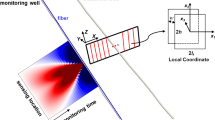Abstract
This paper presents a combined numerical and experimental study on the diffuse ultrasonic measurement technique for determining the depth of surface breaking cracks in concrete. A finite element (FE) model for the dissipative diffusion in a two-dimensional domain with a surface breaking crack is developed using a commercial FE package; for this purpose, the dissipation term is eliminated by a simple change of variables. Three concrete blocks with a crack depth between 25.4 mm to 101.6 mm are prepared. Diffuse ultrasonic measurements are performed on uncracked and cracked concrete blocks, from which the diffuse energy evolution curves are obtained. The basic material parameters of the hardened concrete, i.e. the diffusivity and dissipation, are retrieved, which are needed for the numerical simulations. The crack depths are then determined by comparing the experimental and numerical arrival times of the average diffuse ultrasonic energy. Various geometrical configurations that arise in real-world concrete structures are simulated including an inclined crack, a partially closed crack, two parallel cracks, and a crack with an underlying reinforcement bar. The objective is to investigate the possible limitations of the diffuse ultrasonic measurement technique when implemented in real concrete structures. Finally, it is shown that the time of flight (TOF) of the average diffuse ultrasonic energy constitutes the theoretical basis of the present diffuse ultrasonic measurement of macroscopic cracks and therefore the present diffuse ultrasonic method forms another kind of TOF technique.














Similar content being viewed by others
Notes
The characteristic acoustic impedances of longitudinal and transverse waves in steel are 4.64×107 and 2.60×107 (kg/m2 sec) and those for concrete are 1.03×107 and 0.58×107 (kg/m2 sec). The ratios are about 4.5 for both waves.
References
Anugonda, P., Wiehn, J., Turner, J.: Diffusion of ultrasound in concrete. Ultrasonics 39, 429–435 (2001)
Becker, J., Jacobs, L., Qu, J.: Characterization of cement-based materials using diffuse ultrasound. J. Eng. Sci., 1478–1484 (2003)
Cowan, M., Beaty, K., Page, J., Liu, Z., Sheng, P.: Group velocity of acoustic waves in strongly scattering media: dependence on the volume fraction of scatterers. Phys. Rev. E 58, 6626–6636 (1998)
Deroo, F., Kim, J.-Y., Qu, J., Sabra, K., Jacobs, L.J.: Detection of damage in concrete using diffuse ultrasound. J. Acoust. Soc. Am. 127(6), 3315–3318 (2010)
Hevin, G., Abraham, O., Pedersen, H., Campillo, M.: Characterisation of surface cracks with Rayleigh waves: a numerical model. NDT E Int. 31, 289–297 (1998)
Kee, S.-H., Zhu, J.: Effects of sensor locations on air-coupled surface wave transmission measurements. IEEE Trans. Ultrason. Ferroelectr. Freq. Control 58(2), 427–436 (2011)
Kee, S.-H., Zhu, J.: Surface wave transmission measurements across distributed surface-breaking cracks using air-coupled sensors. J. Sound Vib. 330, 5333–5344 (2011)
Landis, E.N., Shah, S.P.: Frequency-dependent stress wave attenuation in cement-based materials. J. Eng. Mech. 121, 737–743 (1995)
Lin, Y.C., Su, W.C.: Use of stress waves for determining the depth of surface-opening cracks in concrete structures. ACI Mater. J. 93(5), 494–505 (1996)
Lin, Y.C., Liou, T.H., Tsai, W.H.: Determining crack depth and measurement errors using time-of-flight diffraction techniques. ACI Mater. J. 96(2), 190–195 (1999)
Page, J.H., Schriemer, H.P., Jones, I.P., Sheng, P., Weitz, D.A.: Classical wave propagation in strongly scattering media. Phys. Rev. A 241, 66–71 (1997)
Popovics, J.S., Song, W.-J., Ghandehari, M., Subramaniam, K.V., Achenbach, J.D., Shah, S.P.: Application of surface wave transmission measurements for crack depth determination in concrete. ACI Mater. J. 97, 127–135 (2000)
Quiviger, A., Payan, C., Chaix, J.-F., Garnier, V., Salin, J.: Effect of the presence and size of a real macro-crack on diffuse ultrasound in concrete. NDT E Int. 45, 128–132 (2012)
Ramamoorthy, S.K., Kane, Y., Turner, J.: Ultrasound diffusion for crack depth determination in concrete. J. Acoust. Soc. Am. 115(2), 523–529 (2004)
Sansalone, M., Lin, J.M., Streett, W.B.: Determining the depth of surface-opening cracks using impact-generated stress waves and time-of-flight technique. ACI Mater. J. 95(2), 168–177 (1998)
Sheng, P.: Introduction to Wave Scattering, Localization, and Mesoscopic Phenomena. Academic Press, San Diego (2006)
Shin, S.W., Zhu, J., Min, J., Popovics, J.S.: Crack depth estimation for concrete structures using spectral energy transmission of surface waves. ACI Mater. J. 105, 510–516 (2008)
Shurr, D., Kim, J.-Y., Sabra, K.G., Jacobs, L.J.: Damage detection in concrete using coda wave interferometry. NDT E Int. 44, 728–735 (2011)
Song, W.-J., Popovics, J.S., Aldrin, J.C., Shah, S.P.: Measurement of surface wave transmission coefficient across surface-breaking cracks and notches in concrete. J. Acoust. Soc. Am. 113, 717–725 (2003)
Weaver, R.L.: Ultrasonics in an aluminum foam. Ultrasonics 36, 435–442 (1998)
Zhang, Z.Q., Jones, I.P., Schriemer, H.P., Page, J.H., Weitz, D.A., Sheng, P.: Wave transport in random media: the ballistic to diffusive transition. Phys. Rev. E 60, 4843–4850 (1999)
Acknowledgements
This work is partially supported by the Georgia Department of Transportation, Research Project no. GDOT 11-07 (Assessment of Crack Depth in Reinforced Concrete Bridge Elements by Ultrasound Methods). This work is also supported by the DAAD (German Academic Exchange Service).
Author information
Authors and Affiliations
Corresponding author
Rights and permissions
About this article
Cite this article
Seher, M., In, CW., Kim, JY. et al. Numerical and Experimental Study of Crack Depth Measurement in Concrete Using Diffuse Ultrasound. J Nondestruct Eval 32, 81–92 (2013). https://doi.org/10.1007/s10921-012-0161-9
Received:
Accepted:
Published:
Issue Date:
DOI: https://doi.org/10.1007/s10921-012-0161-9




